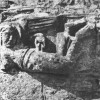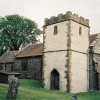NEW BOOKS REVIEW
Tig’s Boys
Letters to Sir from the Trenches
January 1901, the first full year of the 20th century, could rightly be called a milestone year in human history. That month, Queen Victoria and the great Italian composer Verdi died, leaving their respective countries in mourning. But that January also, a grammar school was opened in Bournemouth, then just beginning to expand its borders as a popular resort with a population that had then reached 60,000. The fifty-four boys who were the first pupils of the new grammar, besides their inspiring but severely disciplinarian headmaster, Dr Edward Fenwick, could hardly have imagined that, fourteen years later, those pupils would be pitched, out of a voluntary and patriotic sense of duty, into the bloodiest war the world had then yet seen.
The outbreak of the First World War on August 4th, 1914, inspired many young men to take up arms in what they believed was a just cause on behalf of the empire; but they were largely men already in employment or unemployed, with their schooldays behind them. However, senior boys close to leaving public schools old enough to join up were also inspired to do so, and the boys at Bournemouth grammar were no exception.
But these students did something more. During those terrible four years at the front, Fenwick’s boys, both those who would die and those who would return, maintained a constant correspondence with their beloved master. The re-discovery of these remarkable letters has lead David Hilliam to collate them into a 192-page paperback compilation.
Tig’s Boys is the product of that compilation. It charts in five main chapters reports from the boys on many aspects of day to day life – and death – in the trenches, in the Flying Corps and abroad in the Middle East theatre of war. Chapter five is a moving eulogy by Dr Fenwick on the 98 young Dorsetians from his school killed in action during the conflict. The letters themselves give, sometimes humorous but more often tragic, testimonies of service life, from billeting and blighty to trench-foot, lice, rats and “doing fatigues”; not to mention the outright terror of combat: the shells, machine-guns, snipers and heroic rescues under fire. Take for example the derring-do of Lieutenant H G Head, who describes in his letter on page 34 how he knocked out a German machine-gun post that was badly mauling his company, earning him the Military Cross. Or Private A C Stagg, who lay wounded and without food for 15 days in no-man’s-land before being rescued and treated (p83). The letters display great candour and devotion for the Headmaster who’s stern authority and dynamic energy earned him the pet name of Tig (short for Tiger).
Tig’s Boys opens with the traditional introduction, followed by a two-page timeline tabulating the major battles and other strategic developments throughout the war, then a prologue (Tig and his School) featuring an account of the development of the Grammar School from foundation to the outbreak of war. Centrally placed are 30 black-and-white plates of the headmaster, his former pupils, and war scenes. On the back pages are 1919 and 21st century epilogues, a short bibliography, index and two appendices, one being a month-by-month roll of honour for the dead, the second, a roll for those decorated for valour.
Tig’s Boys was published first by Spellmount, then in the present paperback format by The History Press (2011). It is £12.99.
We have posted a photo of the book cover in the photo section.



